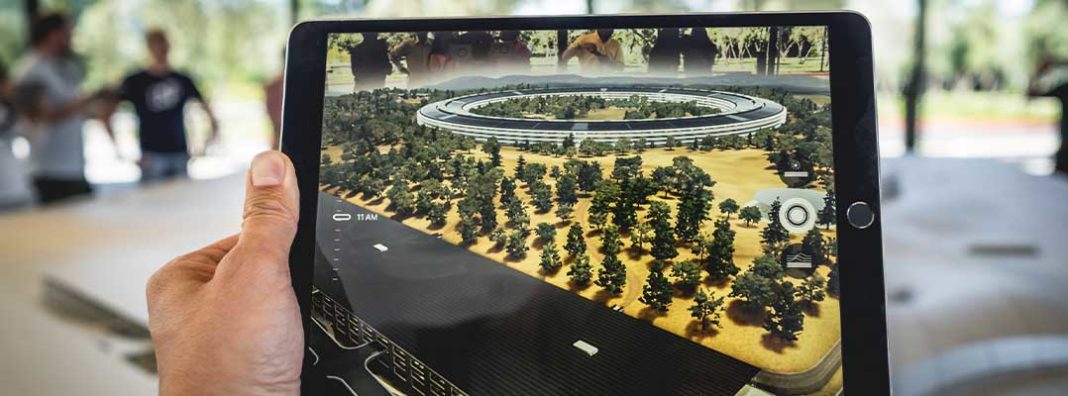
As someone who studies technology and innovation policy, I pride myself on being a futurist. That means I have my sights set on the future, and I believe fervently in its promise. With that said, as we turn the page on 2020, I remain determined to welcome 2021 with an optimistic and forward-looking gaze.
In that spirit, let’s talk about the future — from what’s out there left to be explored to what has finally revealed itself on the horizon of possibility. Let’s talk about the year 2021 and what we hope it brings. After all, why write about tech policy if you can’t take time to write about the fun stuff, marvel at the creations of some of the best and brightest minds, and make wild predictions about what’s to come? To me, that’s the best part of the job.
So without further ado, allow me to present my top three 2021 tech innovations in the new year. Let’s call them “Caden’s Innovation Inspirations” until something better comes along.
#1 Augmented Reality Glasses
Remember Google Glass? If Google’s once-promising augmented reality concept from the early 2010s brings back heartbreak, check out Facebook’s new project, Aria. This augmented reality glasses concept is a nice compliment to the social networking company that purchased virtual reality stand-out Oculus in 2014. Described as the next big thing in wearable tech, Aria is the source of much anticipation from VR/AR nerds like myself because it aims to transform the way we interact with our world. In its nascent stage, the glasses will monitor the world around you, which will allow it to do simple, handy things like reminding you where you left your keys and displaying the customer ratings for a restaurant you are walking into. However, I have more ambitious expectations for augmented reality glasses like Aria.
One of the exciting promises that I see for augmented reality glasses is creating the illusion of holograms. If you haven’t already tried to think through creating a hologram, it’s basically impossible to create one without some illusion at play. Enter augmented reality, where you can create the illusion of a hologram, and no one is the wiser. That means, for all you Star Wars fans, you may someday be able to teleconference with someone as if they’re sitting in an adjacent chair like the Jedi council.
But the innovation also inspires another possibility, one where forgetting someone’s name at a networking event is a thing of the past. It is not far-fetched to think that Facebook’s Aria could use biometric information to predict the identity and name of the person standing in front of you and display their name for you. As someone who often forgets names, this kind of innovation (setting aside the problems posed by privacy concerns) would receive a warm welcome from me.
Of course, Google Glass didn’t become a distant memory simply because there wasn’t demand. Facebook’s Project Aria team will need to parse through loads of ethical and legal questions as they test their AR glasses. But even with some of the simple functionality already possible in their concept product, great promise, this innovation has.
#2 Driverless Vehicles (and my millennial dream of a self-driving RV)
One of the innovations I’ve been following for a few years now is fully autonomous and semi-autonomous vehicles (AKA driverless cars). The technology necessary to create driverless cars is still in the nascent stage, at least in terms of consumer roll-out, but most experts agree that driverless cars will transform transportation in both the consumer vehicle market and the commercial trucking market. Ordinarily, that kind of promise would be enough to put driverless vehicles high on my tech watchlist for 2021. Still, there’s a question I’ve been asking lately: what about the Recreational Vehicles market?
If autonomous RVs sound like a detour from the important uses of autonomous vehicle capabilities, think again. In the past two years, 73 percent of millennials, myself included, indicated that they were likely to take an RV road trip in the future. As the most educated and largest segment of the workforce, many millennials shifted to remote work arrangements at the beginning of the pandemic. Many of us, again myself included, also live in small, overpriced apartments. Thus, it really comes as no surprise that we would desire adventure in the comfort of an RV.
I confess that working from the comfort of an RV overlooking the beautiful Blue Ridge mountains would be a dream come true. But there is one major problem standing in the way of my dream: I can’t drive anything larger than a four-door sedan without bumping into something. One can only imagine me driving down the highway in a Winnebago, jumping from lane-to-lane like a life-sized game of pinball.
But there is hope for me and other vehicle-challenged, cooped up millennials yet. As early as 2018, Commentators began speculating that Winnebago could soon develop the world’s first self-driving RV. In 2019, with the release of Tesla’s self-driving Semi, commentators put two-and-two together and began to write about a Tesla self-driving motorhome concept.
Combining the rumored concepts, the increase in RV demand, and the improvements made in autonomous vehicle capabilities, I’d argue that, at the very least, we have an emerging technology on our hands. But regardless of whether this is a pipe dream, I am inclined to believe that it is only a matter of time before I write to you from the comfort of a Winnebego looking out over some hideaway deep in the mountains.
#3 Cloud Gaming Services as the PC of the Future
The innovation I have personally enjoyed the most since 2021 began is cloud PC streaming.
More reality than concept, cloud PC streaming is primarily used in the PC gaming community. Cloud streaming helps answer the question: What’s a gamer to do with a low budget, Dorito dust-covered computer? As anyone with an itch for gaming beyond Solitaire knows, downloading and running a PC game on an old, maxed out PC can make Cyberpunk 2077 look like a smooth, bug-free experience. But perhaps more important is the fact that even standard setups can cost a pretty penny.
After I installed the required software to take the October remote bar exam, I noticed massive drops in performance on my PC. I looked on with despair as I browsed for replacements, the price of which far exceeded my budget. That was when one cloud gaming service, Shadow, caught my attention. Developed by the French computing company Blade, Shadow is a cloud streaming service that allows users to remote-in to one of many computers set up in large complexes resembling bitcoin mining facilities. These computers are equipped with the latest PC hardware, which can be accessed for an affordable monthly subscription fee. What’s more, the service only requires a connection of 15 to 25 Mbps to operate, meaning even low-budget internet service plans can handle the bandwidth.
But it is not the gaming component of Shadow that has me inspired going into this year. Admittedly, I am not much of a gamer at all. Instead, it is the computing capabilities that Shadow offers that have me raving about the future. Shadow doesn’t limit you to a library of games like competitors Stadia and XCloud. Instead, Shadow gives you access to a fully loaded Windows 10 computer that you can customize for your needs. In my case, I use my Shadow PC to do legal research (a process that is oddly taxing on my personal computer).
Of course, if you’re looking to stream movies or use your Shadow for gaming, latency issues could put a damper on your hopes for the service. But going forward, these gaming solutions look more to me like the future of computing than the future of gaming. I believe the trend toward cloud streaming services will outpace the trend toward beefy personal computers in the near future. Practically speaking, the shift toward cloud computing would mean that even consumers who can’t shell out for the high-cost, cutting edge computers will be able to access the computing power needed to learn, contribute, and improve in a world increasingly dependent on computers.
Conclusion
All-in-all, there are undoubtedly other innovations we can expect and speculate about. Perhaps they are even better than the top three I described. After all, a pair of AR glasses, a self-driving RV, and a PC streaming service will probably do more to elevate my own state of existence than someone else’s. Regardless, if you think 2021 got off to a rocky start, rest assured, the future of tech and innovation is bound to bring some brightness into our lives. At the very least, now you have three good reasons to look forward, inspired by what could be in this year, 2021.

